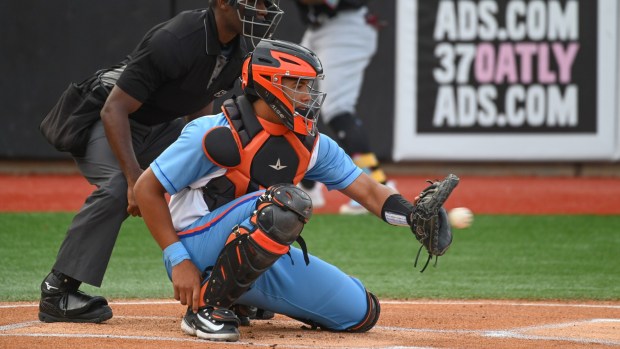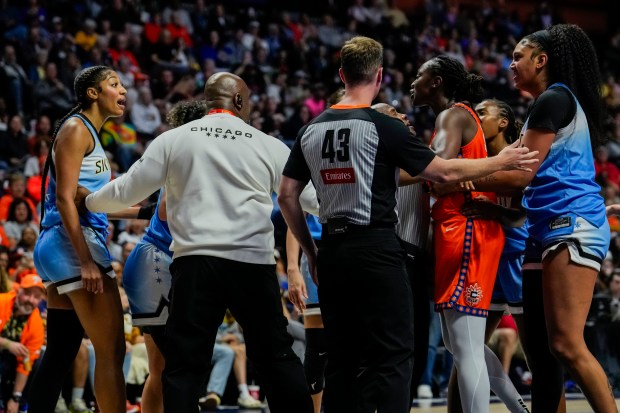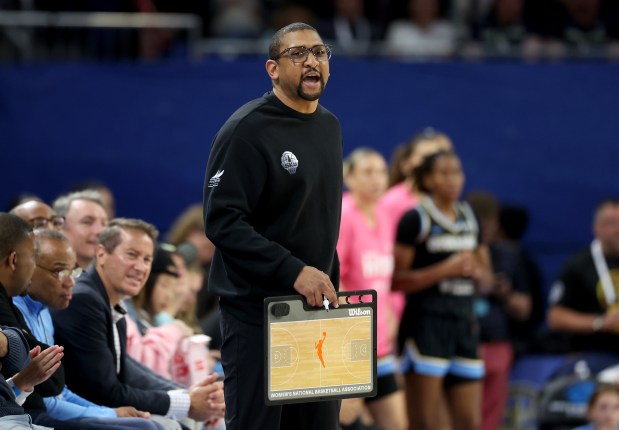SARASOTA, Fla. — Samuel Basallo stands tall at his locker, a boy among men, just feet from Adley Rutschman.
The 19-year-old catching prospect has the body of a big leaguer — 6 feet 4 and perhaps still growing — but the face and wide smile of a teenager. He’s the youngest player at Orioles spring training, but that doesn’t mean he’s inexperienced or immature.
Growing up in the Dominican Republic, Basallo dreamed of playing in the major leagues. He began training like a professional at 12 years old, waking up at 4:30 a.m. for two-a-day workouts at his academy. He was originally connected to the New York Yankees before he was again made available and the Orioles swooped in. He signed for a then-franchise-record $1.3 million at 16 years old — the headliner of the first major investment by the new regime after decades of the organization largely passing over the Latin American market.
A year ago, Basallo wasn’t a known commodity or considered a central part of the Orioles’ future. He put up solid but unremarkable numbers in short-season ball, and his future in the majors, if he had one at all, was at least several years away. He wasn’t anywhere near top 100 lists, ranked by Baseball America as the Orioles’ 15th-best prospect. His raw power was intriguing, but whether he’d keep up against better pitching or play well enough behind the plate were unanswered questions.
Now, after an unprecedented 2023 season in the minors, Basallo has risen to become one of the best prospects in baseball. He’s ranked No. 10 on Baseball America’s top 100 list, behind just one other catcher. He will likely become the Orioles’ best prospect in 2024 when Jackson Holliday graduates from such status, and Basallo has a chance to follow Holliday, Gunnar Henderson and Adley Rutschman as Baltimore’s fourth straight No. 1 overall prospect.
“This kid is special,” said Koby Perez, the Orioles’ vice president of international scouting and operations. “He’s different.”
A distant dream
His family calls him Samuel (pronounced sam-well), but everyone else calls him Basallo.
As a teenager growing up in Santo Domingo, when he participated in showcases for professional scouts, there were sometimes other Samuels on the field. But there was only one Basallo.
Orioles scouts describe the Basallo family as tight-knit and supportive, with his parents instilling “good values” in their three kids — Basallo the middle child between his older sister and younger brother, who could also have a future as a ballplayer.
A player’s upbringing, values and work ethic are integral parts of makeup — an intangible that is still a massive part of scouting despite the rise of analytics in the majors. It’s even more important when evaluating the international market, whose players are sometimes scouted before they hit puberty and are signed before they’d be allowed to drive in most states.
“We’re a really united family,” Basallo said through team interpreter Brandon Quinones. “There’s five of us, but we’re really one. We’ve always been that way. My mom and dad have always said it’s important to stay close and really fight for what you want to accomplish in life.”
Basallo started training at Ivan Noboa’s Baseball Dreams Academy — one of the premier locations for young talent in the Dominican Republic — when he was 12 years old in 2017. Noboa, who began working with ballplayers in the late 1990s, has trained 23 big leaguers, including Emilio Bonifácio, Nomar Mazara and Jasson Domínguez, who is currently the Yankees’ top prospect after signing for a whopping $5.1 million in 2019.
Noboa said Basallo and the other players at his academy train five days a week — from hitting and fielding drills to simulated games to strength and conditioning workouts — beginning at 5 a.m. and ending at 6 p.m. with a 3 1/2-hour break in between. Basallo lived at the facility during the week and went home on the weekends.
“He always had a really good work ethic,” Noboa said. “I expect to see Basallo in the big leagues for a long time.”
Basallo was just a boy when he began training like a man. He was told he had the talent to go places, but those expectations were at times a burden.
“You do feel some of that pressure, and it is difficult,” he said. “You feel the pressure knowing your family’s future is in your hands, that everything you want is in your hands.”
Basallo wears a necklace with the letter “B” hanging from it, close to his heart, as a reminder of his family back home and a display of his pride to be a Basallo. He said his dream of reaching the major leagues and providing for his family are no longer a burden, but that doesn’t mean he’s satisfied.
“I would call it motivation,” Basallo said. “Motivation to continue going and reaching my goals.”
A patient pursuit
Before the Orioles hired Mike Elias to be their general manager in November 2018, the organization’s presence in the international market was scant.
Perez, hired by Elias in January 2019 to revamp the organization’s underused international scouting operation, said it was actually impressive the Orioles were able to have success from 2012 to 2016 without it. Many of the sport’s top players — Ronald Acuña Jr., Juan Soto and Jose Altuve — were signed as teenagers out of Latin America.
“Not playing in the international market is like starting out in a video game at 60 or 70% life,” Perez said.
That’s not to say every international investment works out. In fact, there are more unpredictable variables for international prospects given the young age at which they’re signed. It can also be more difficult than domestic scouting, as the MLB draft provides a structure for sorting out which teams get the best young players in the U.S. In comparison, the international market is the wild, wild west — akin to major Division I college recruiting.
“That’s exactly what it’s like,” Perez said.
Orioles catching prospect Samuel Basallo began last season in Low-A Delmarva. He ended it in Double-A as the youngest player at the level. (Brian Krista/Staff)
The Orioles were behind the eight-ball when Perez was hired, meaning the 2019 international class wouldn’t include any top names. In addition to finding under-the-radar players for the initial group, Perez and his staff focused heavily on the 2020 class. One of the names at the top of their list: Basallo.
Perez was with Cleveland when he first saw a 14-year-old Basallo play in 2018. Gerardo Cabrera, the Orioles’ Latin American scouting director, was with the New York Mets in 2017 when he watched a pre-teen Basallo play shortstop — his position before he switched to catcher at 13 when it became clear he would grow out of being a middle infielder.
“He was a big kid for his age and he had tremendous power,” Cabrera said.
Scout Michael Cruz was an early hire of Perez’s in January 2019, assigning him as an area scout to cover Santo Domingo. Cruz began scouting Basallo in April at Noboa’s academy, immediately noticing Basallo’s size, power and arm strength.
“He can be special,” Cruz recalls thinking.
But just weeks later, it appeared to the Orioles that Basallo was “off the market,” Perez said. Players can’t officially sign until they turn 16 years old, but oral agreements are commonplace, though neither the player nor the team is bound until pen meets paper. The Orioles wouldn’t comment on which team they believe had an oral agreement with Basallo, though one scout noted it was another AL East team. Basallo said he knew the Yankees “were really interested in me.” Noboa said there was never an oral agreement but noted the Yankees, Boston Red Sox and Texas Rangers were interested in Basallo — especially the Yankees, who made a “very attractive offer.”
No matter the specifics, it took just a few months for Basallo to be back “on the market” in the Orioles’ eyes, and that’s when Baltimore ramped up its efforts.
“If I got into the same situation and I had a kid like Basallo and something happened and another team signed him, yeah, to be honest, I would be pissed,” Cabrera said. “You don’t find those talents often.”
Over the next year, Cruz spent about 20 hours a week watching Basallo play, practice, work out and interact with his teammates. The more Cruz watched, the more he was convinced Basallo was the real deal.
“When you watch Basallo play, the tools are there. But what made the difference was his personality, the makeup,” Cruz said. “When you find a player like that, you have to be really close. This market moves really fast. If you fall asleep, somebody else can go in and sign the player.
“And when you hit the jackpot, it feels really good because you were right.”
To attempt to seal the deal, the Orioles brought in their closer: Elias. Like a college football coach visiting a recruit’s home to show the family the program’s commitment, Elias went to the Dominican Republic twice to see Basallo play.
“You don’t often see a GM here in the Dominican Republic,” Cabrera said. “That helped us a lot to be able to get Basallo.”
Noboa said what put the Orioles over the top was the belief they could develop Basallo and move him through their system quickly. It took a bit longer for the agreement to be officially announced because the coronavirus pandemic pushed the 2020 signing period back several months. Once the $1.3 million deal was official, Basallo said he and his family first “thanked God for everything” and then welcomed relatives and friends — including Cabrera and Perez — to their home to party.
“We felt like we had all accomplished something that day,” Basallo said.
A stunning rise
If it weren’t for Rutschman, Basallo would undoubtedly be the Orioles’ future at catcher. If it weren’t for Holliday, Basallo would be the wunderkind atop Baltimore’s farm system.
Holliday has assumed the mantle as the third straight Oriole to be baseball’s No. 1 prospect after his historic 2023 campaign in which he climbed from Low-A to Triple-A in his first full professional season. Basallo’s 2023 season was just as impressive.
“If we didn’t have a player named Jackson Holliday, people would be amazed by what Basallo did,” said Matt Blood, the Orioles’ vice president of player development and domestic scouting. “It’s not normal for one player to do that, but to have two is very rare.”
After posting a .762 OPS between the Dominican Summer League and Florida Complex League in 2021 and 2022, respectively, Basallo began last season, his age-18 campaign, in Low-A Delmarva. He ended it in Double-A as the youngest player at the level. After hitting .299 with an .887 OPS for the Shorebirds, Basallo dominated with High-A Aberdeen (a stop many Orioles prospects struggle at) with a .333/.444/.688 slash line. His 1.131 OPS in High-A was by far the best of any player in his age-18 season at the level since at least 2006 — ahead of Mike Trout (.821 in 2014), Vladimir Guerrero Jr. (.944 in 2017) and Wander Franco (.872 in 2019).
“I don’t want to say I was shocked,” Perez said. “I knew he would get there eventually, but not as quickly as he did.”
“I wouldn’t have bet on it,” Blood said, ‘but I also don’t bet against him. He has a similar type of a makeup and drive and skill set to players like Gunnar or Coby [Mayo] or Jackson — the kind of makeup, like, ‘You’re not going to stop me.’”
Josh Bunselmeyer has been Basallo’s primary hitting coach since the youngster’s first season with the Orioles in 2021, moving up the ladder as the catcher has. Bunselmeyer has videos on his phone of a 16-year-old Basallo hitting, and they sometimes look back and laugh at how much his swing has improved.
Bunselmeyer, who was Delmarva’s hitting coach in 2023 and will be Bowie’s this season, said Basallo’s work ethic is “unparalleled.”
“From the time he was in the Dominican to his time in Florida and last season, we knew this was in there,” Bunselmeyer said. “We just had to keep chipping away at it. To see him take off and get all this recognition, it feels really good to see that work come to fruition.”
It became clear to external prospect rankers early last season that Basallo was someone who needed to move up — and quickly. Now, he’s considered one of the minors’ top sluggers.
“He’s one of the best combinations of hitting ability and power in the minors regardless of age,” said Jim Callis, who covers prospects for MLB Pipeline, whose rankings have Basallo at No. 17. “Then you factor in the age and it’s even more exciting.”
The reality with Basallo, though, is he’s just a cherry on top of what is already the sport’s best farm system.
Many of Baltimore’s best prospects were taken early in MLB drafts, as Rutschman, Holliday, Heston Kjerstad and Colton Cowser were all top-five picks during the Orioles’ rebuild. Perez said the goal when he was hired was for the international investments — Basallo is now one of five players to receive seven-figure bonuses from the Orioles — to bear fruit at the same time the big league club ended its rebuild and began picking later in the draft, hoping the players from Latin America would keep the farm system strong. Basallo is one of seven international prospects signed by the Orioles who Baseball America ranks inside the organization’s top 30.
“Now the work is starting to show,” Perez said. “I think it’s worked perfectly.”
Basallo hasn’t played much this spring as he’s rehabbing a stress fracture in his throwing elbow that will prevent him from catching in games until at least April. He made his Grapefruit League debut earlier this week, and Thursday night, Basallo started at designated hitter and batted fifth in the Orioles’ prospect-filled Spring Breakout game. He will likely begin the season in Double-A, and while his bat could move faster than his defensive ability, the Orioles remain committed to keeping him as a catcher. Despite his size, which is similar to that of former Orioles catcher Matt Wieters, Basallo’s plus arm and freakish flexibility — he can do a full split, Perez said — give Baltimore’s brass confidence his future is behind the plate.
With just eight players between Basallo and Holliday on Baseball America’s top 100, it’s possible the former follows the latter to give Baltimore a fourth straight No. 1 overall prospect. It’s unlikely — as it would be for any individual prospect — but after his breakout 2023 campaign, it would be unwise to doubt him, Blood said.
“With the right roll of the dice, he can absolutely be the next No. 1,” he said. “He has all the skills, he’s super young, he’s got phenomenal makeup. There’s no reason why he couldn’t be the No. 1 prospect.”
That bright future was never certain until recently. A year ago, Basallo was far from a top prospect. Four years ago, he was showcasing his talents in the Dominican Republic hoping an MLB team would sign him. Seven years ago, he was a young boy at the beginning of a journey he yearned would one day lead him to the major leagues.
It might not be long before that dream becomes reality.





